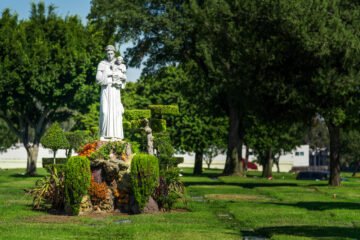A Journey Through Symbolism in Catholic Churches and Cemeteries
Exploring Catholic Symbolism in Catholic Churches and Cemeteries
The Role of Symbolism
Symbolism in Catholic churches and cemeteries offers a profound insight into the spiritual and cultural dimensions of life, death, and the hereafter. This approach goes beyond mere religious practices, delving into a rich tapestry of symbols, rituals, and architecture that embody the Catholic faith’s connections with the journey of the soul.
Symbolic Architecture and Art in Catholic Churches
In Catholic churches, symbolism is pervasive and intentional. The architecture, often cruciform, represents Christ’s sacrifice. Stained glass windows serve as visual gospels, narrating biblical stories and the lives of saints, while statues of saints provide tangible connections to the communion of saints. The altar, as the focal point, symbolizes Christ as the cornerstone of faith.
Color Symbolism and Its Significance
The use of specific colors in liturgical vestments and church decorations follows the liturgical calendar, with each color reflecting a different aspect of the faith. White symbolizes purity and joy, purple denotes penance, green represents hope and life, and red signifies the Holy Spirit and martyrdom.
The Symbolism in Catholic Cemeteries
Catholic cemeteries extend the symbolism from the church to the resting places of the deceased. These spaces are not just for mourning but also for connecting with the departed within the context of a faith that emphasizes resurrection and eternal life. Headstones and mausoleums often feature symbols like the cross and the Chi-Rho, reflecting the belief in life after death and the hope of reunion in the hereafter.
As you step into a Catholic cemetery, you’re immediately enveloped in a space that is both somber and reflective. Here, the interplay of symbols and architecture creates an atmosphere that speaks to the deep roots of Catholic tradition and belief.
The Presence of Angels

One of the first things you might notice are the statues of angels. Some are poised gracefully over tombstones, while others stand tall and majestic. These angels, beyond their immediate beauty, are steeped in Catholic symbolism. They are seen as messengers and guardians, representing the link between heaven and earth. Their presence in the cemetery serves as a comforting reminder of the eternal watchfulness and protection offered to the souls of the departed.
Symbolism of the Cross
As you walk further, the cross, a central symbol in Catholicism, is ever-present. It stands not just as a marker of individual graves but as a universal symbol of Christ’s sacrifice and the hope of resurrection. The cross reaffirms the Catholic belief in life after death and the redemption of souls.
Statues of Saints and the Virgin Mary

Throughout the cemetery, you’ll likely encounter statues of various saints and the Virgin Mary. These figures are not mere decorations but are integral to Catholic faith and practice. Each saint has a story, a life lived in virtue and faith, offering a model for the living. The Virgin Mary, often depicted in a stance of prayer or holding the infant Jesus, symbolizes unconditional love, compassion, and intercession for the faithful.
Inscriptions and Iconography
On headstones and mausoleums, inscriptions and iconography tell stories of faith and devotion. Phrases from the Bible, images of the rosary, or symbols like the Chi-Rho (a monogram of Christ) provide a window into the beliefs and values held by those who have passed on. These symbols serve as a testament to a life lived in faith and a soul continuing its journey in the afterlife.
The Overall Atmosphere
Walking through a Catholic cemetery, you’re likely to feel a sense of solemnity mixed with hope. The cemetery is a place of remembrance and prayer, where the living can connect with their departed loved ones. It’s a space that encourages reflection on one’s own life, mortality, and the spiritual journey beyond death.
Consecrated Spaces in Catholic Tradition
In Catholic tradition, both churches and cemeteries are consecrated spaces, considered sacred and set apart for divine purposes. This sanctity is experienced tangibly by the faithful, providing solace and hope, and offering a physical and spiritual place for reflection on life’s transient nature and the eternal journey of the soul.
A Real-Life Interpretation of Catholic Symbolism: The Notre-Dame Basilica of Montreal
Overview
Catholic symbolism in churches and cemeteries provides a profound insight into the spiritual and cultural dimensions of life, death, and the hereafter. This symbolism is not only an expression of religious belief but also a powerful medium for contemplating and celebrating the mysteries of life and the afterlife.
The Notre-Dame Basilica: An Exemplar of Catholic Symbolism
Architectural and Spiritual Significance
The Notre-Dame Basilica in Montreal is a testament to the deep Catholic symbolism through its design and decoration. The basilica, which began construction in 1824 and was completed in 1829, was originally designed by James O’Donnell in the Gothic Revival style, profoundly influencing Canadian architectural trends.
Interior Embellishments and Symbolism
Under the guidance of Victor Bourgeau, the basilica’s interior was inspired by the Sainte-Chapelle in Paris, evident in the use of color and gold-leaf motifs. The grand altarpiece in the sanctuary offers a “theological lesson” on the Eucharist, featuring biblical scenes and figures that symbolize Christ’s sacrifice and presence in the Christian faith.
Unique Features of the Basilica
The Pulpit of Truth, a magnificent work crafted by Louis-Philippe Hébert under Bourgeau’s direction, represents the components of Christian faith. Additionally, the Great Casavant Organ, built by Casavant Frères and completed in 1891, complements the spiritual atmosphere with its 7,000 pipes.
Cultural and National Significance
Beyond its religious importance, the Notre-Dame Basilica has hosted various cultural and national events, underscoring its role as a central symbol in Montreal and Canada’s cultural and spiritual landscape.
Concluding Reflections
The Notre-Dame Basilica of Montreal serves as a vivid example of how Catholic symbolism in architecture and art can provide solace, guidance, and a sense of continuity that transcends the material world, offering a space for reflection on life’s transient nature and the eternal journey of the soul.




